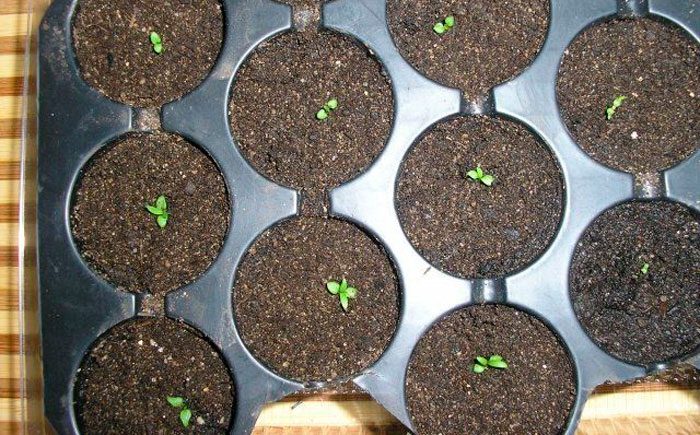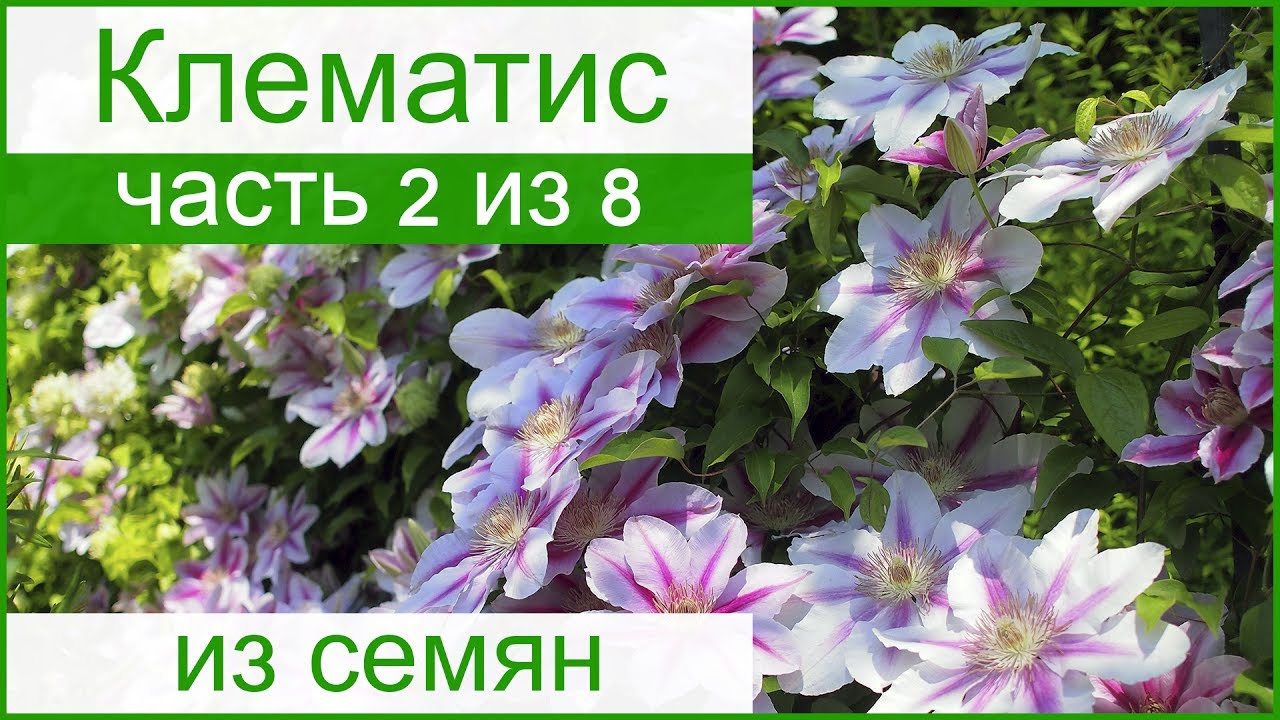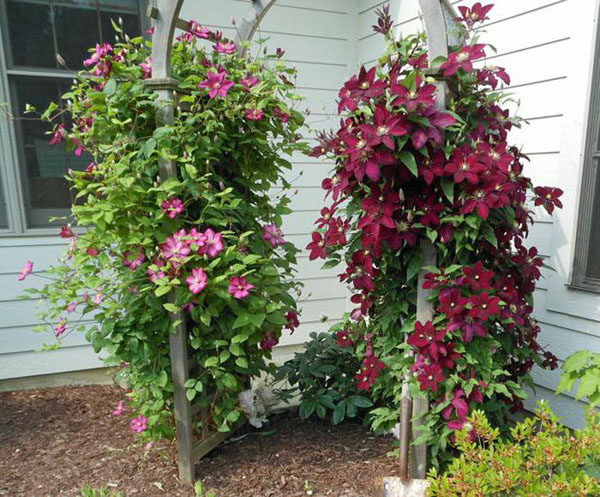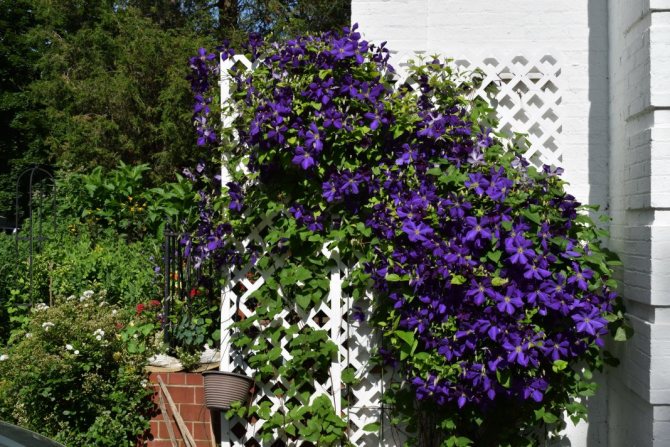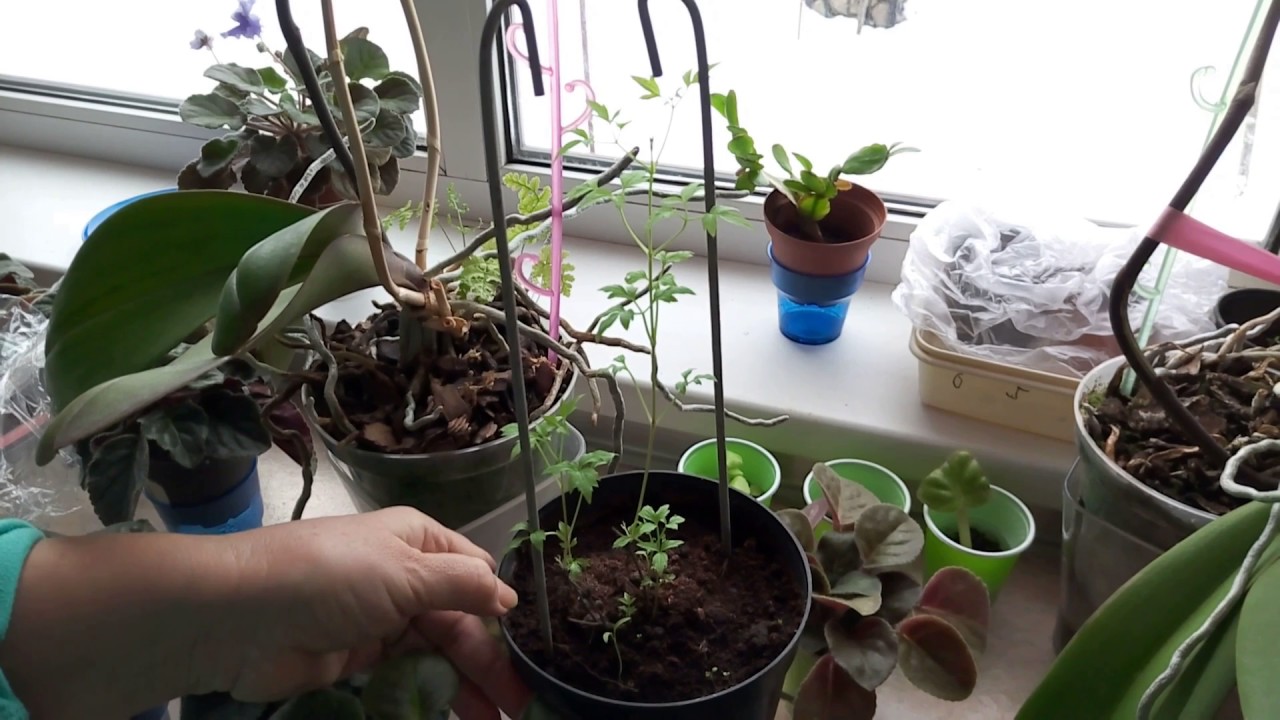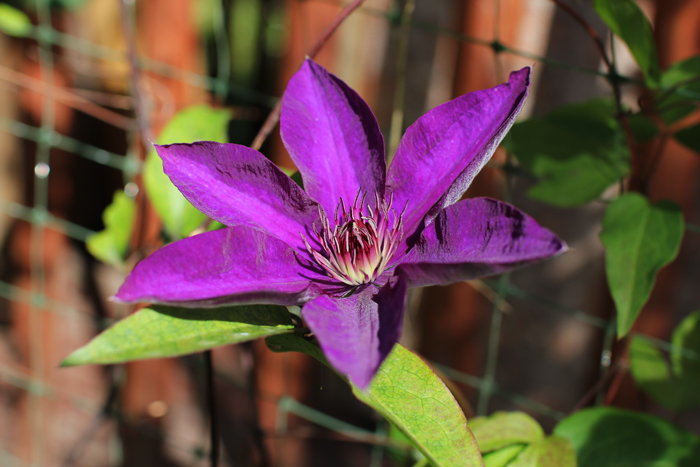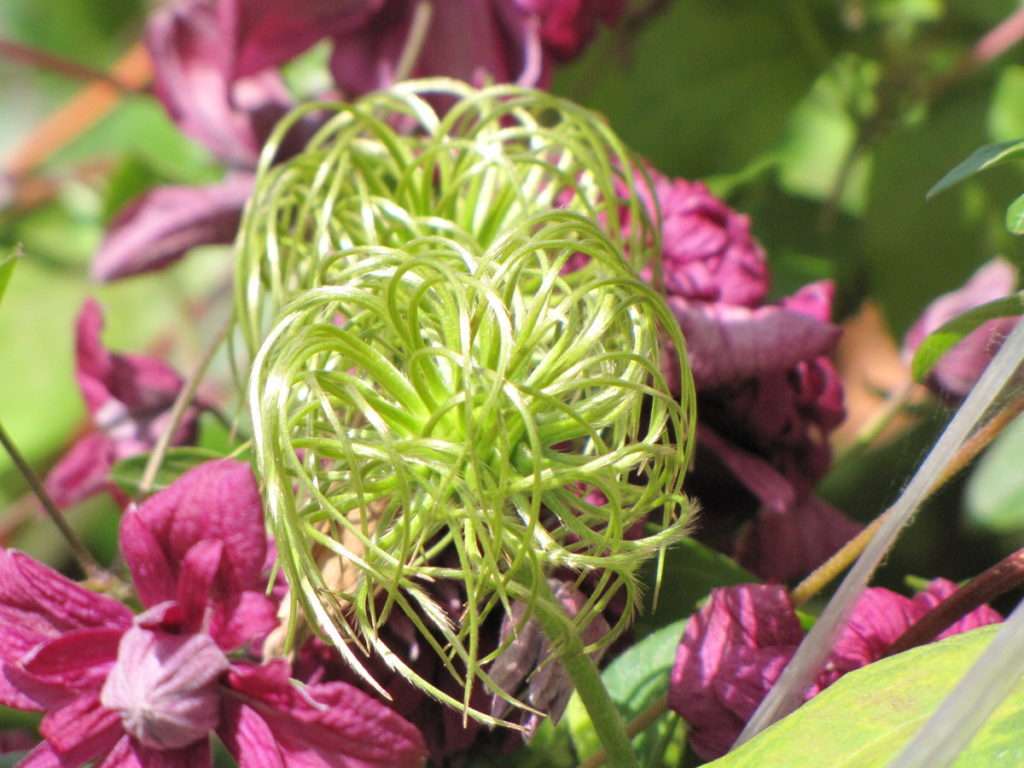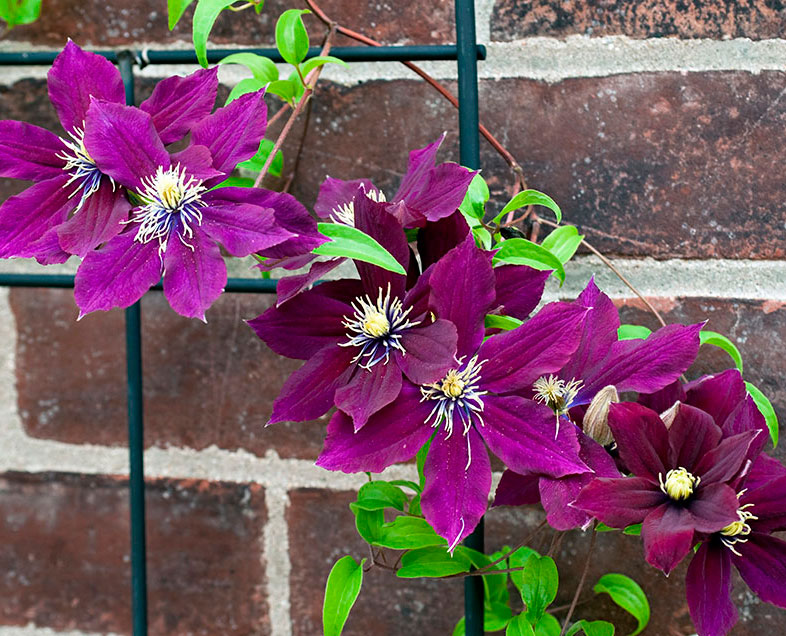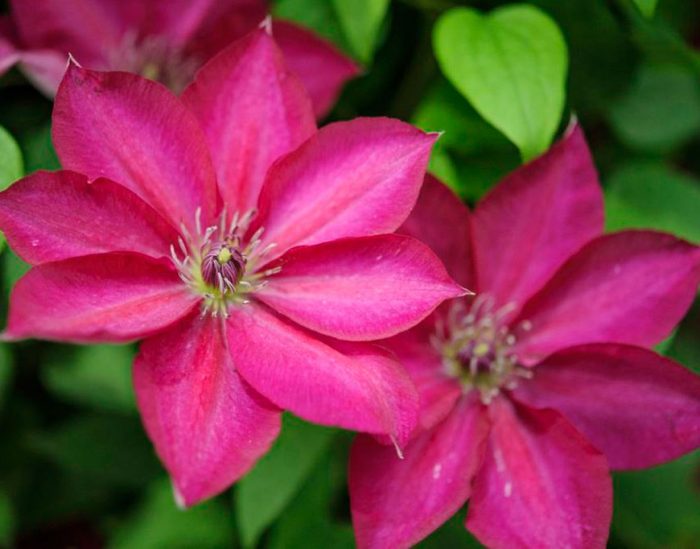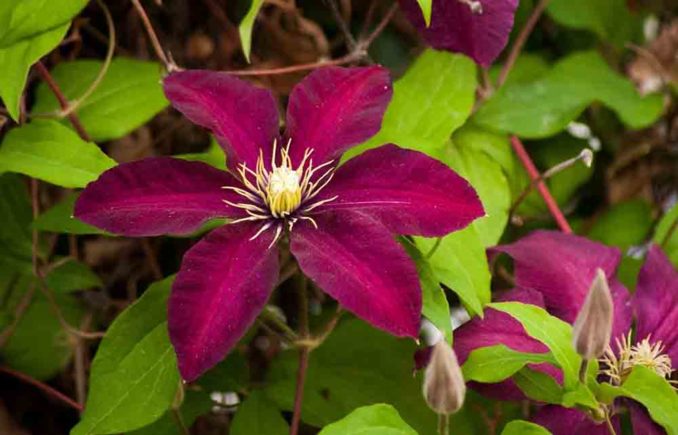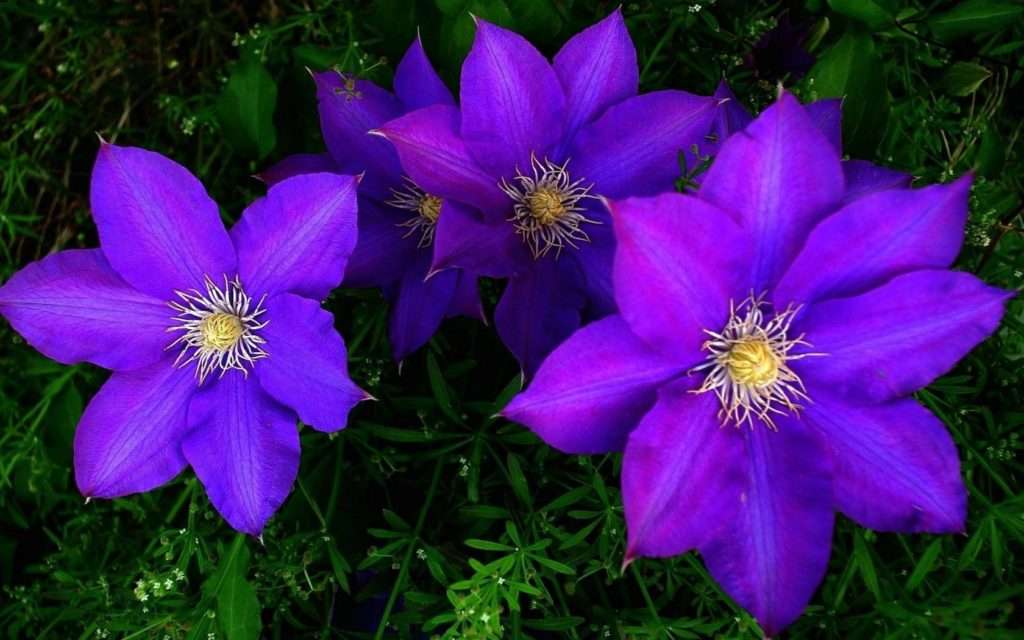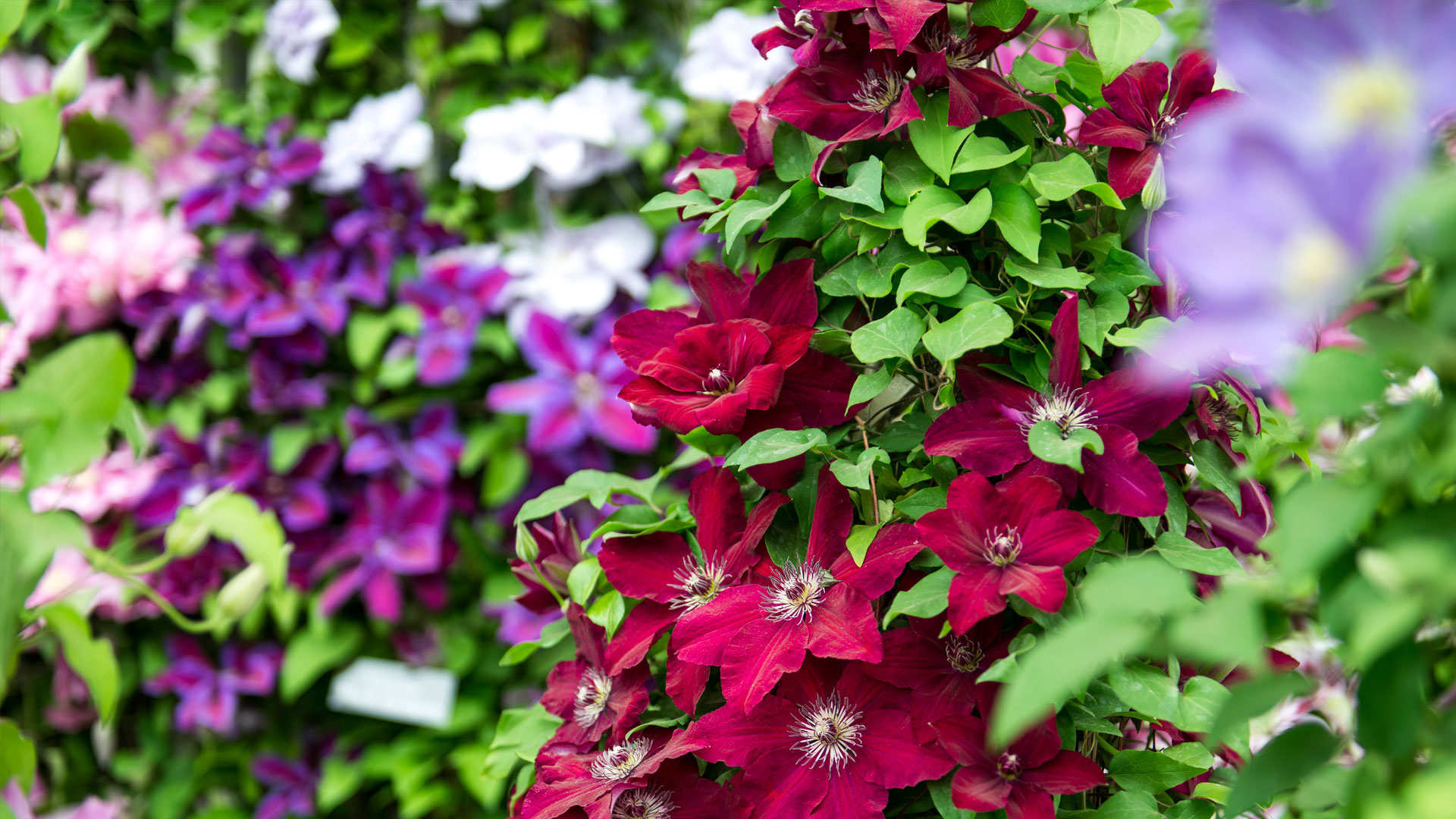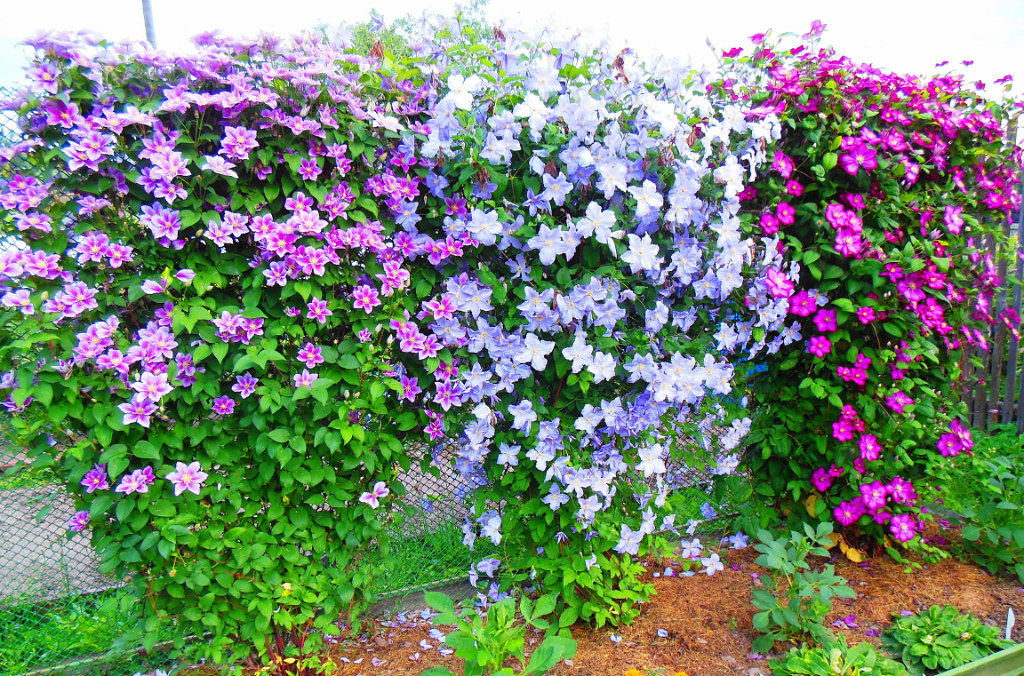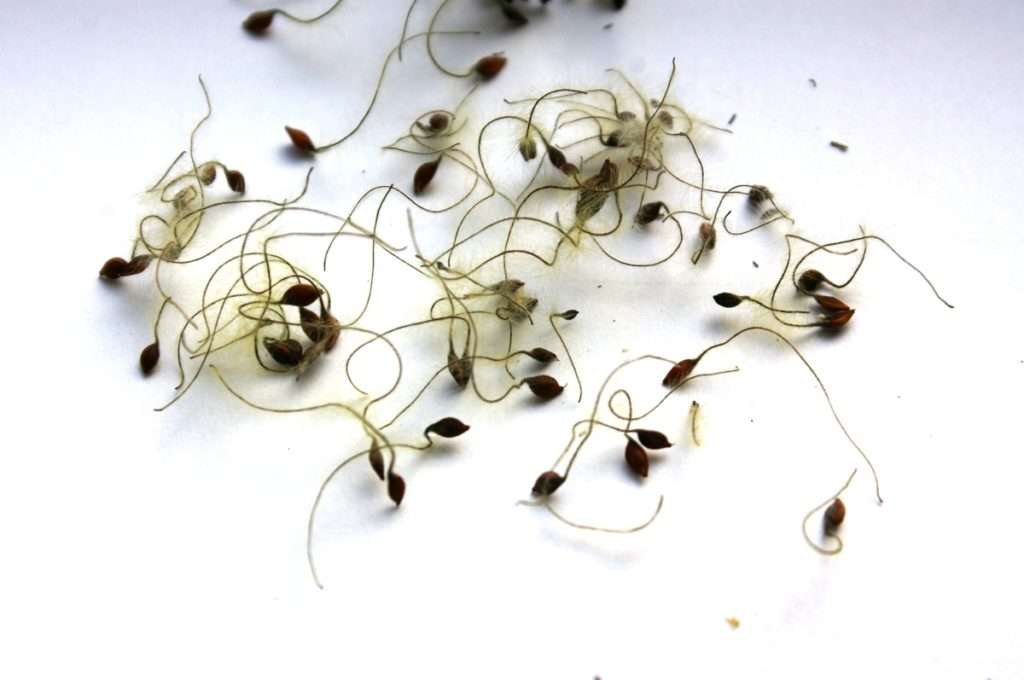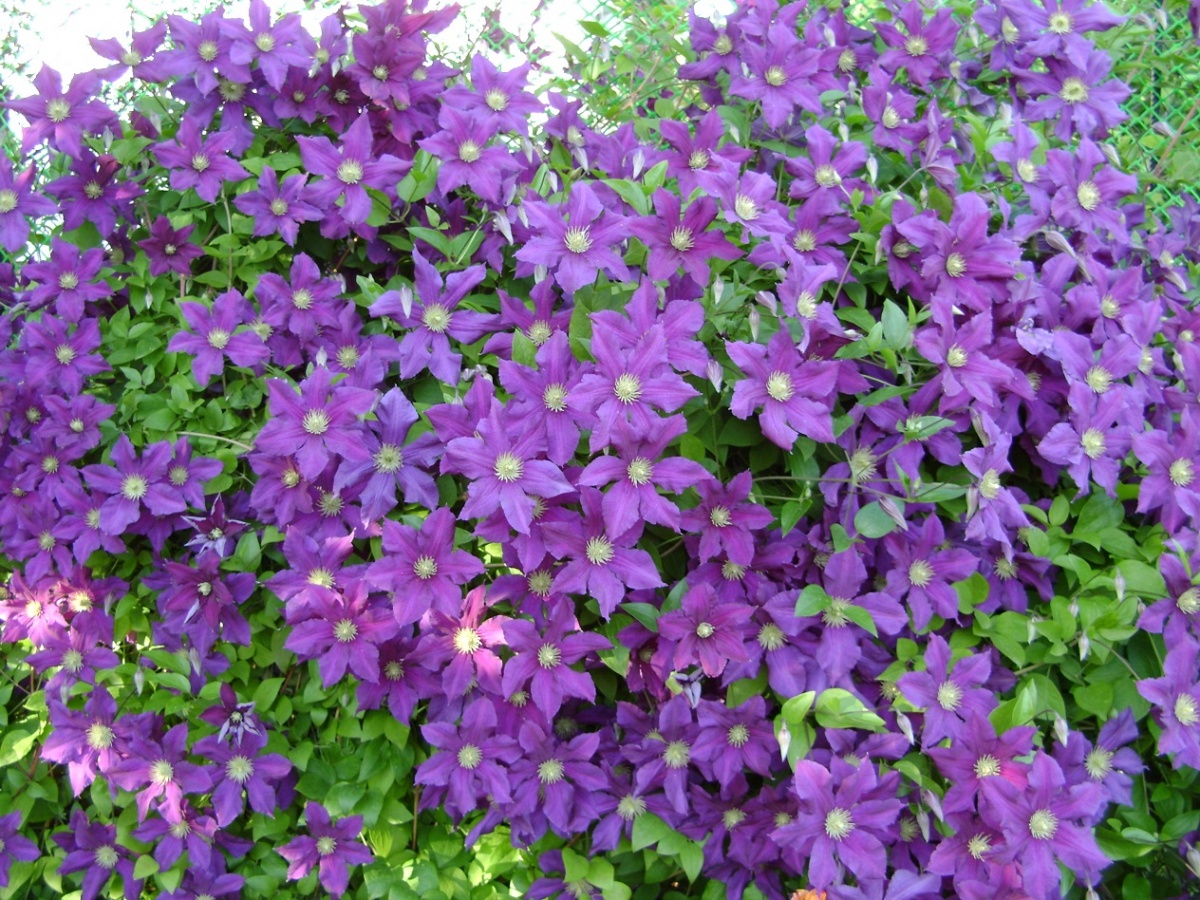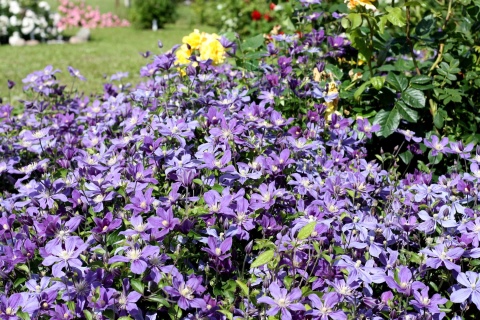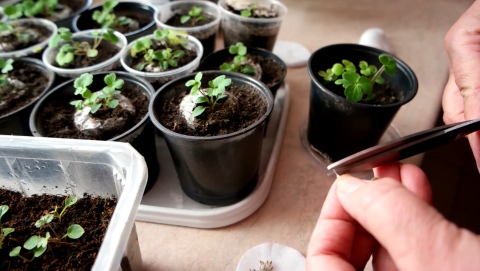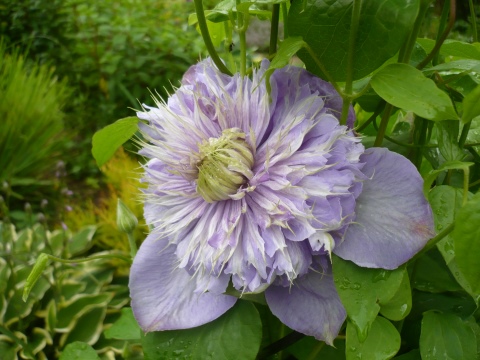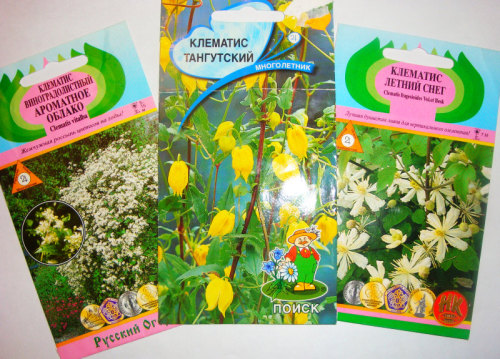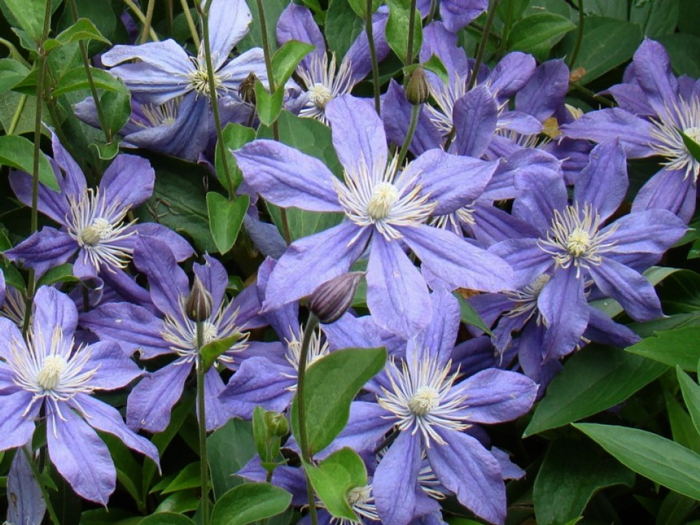Care of young plants
When the seedlings grow up to two pairs of leaves, they are dived in separate pots or planted in the ground at a distance of 20 cm from each other. Caring for them consists in periodically pinching the shoots when they begin to grow back - this will make it possible to actively develop the root system, and not build up the green mass. The land between the rows is loosened and mulched after each irrigation with humus and ground cover and perennial plants are planted around, for shading, so that it does not overheat and does not dry out.
The aerial part of the plant develops slowly - first, the root system grows, and then the green shoots. Growing and caring for young clematis from seeds differs from the agricultural technology of adult vines. They need to be watered and sprayed, weeds weeded, fed regularly and correctly: about once every 2 weeks. Ash mixed with rotted mullein and superphosphate is used as fertilizer. With this method of propagation, plants usually bloom in the second or third year, depending on the variety.
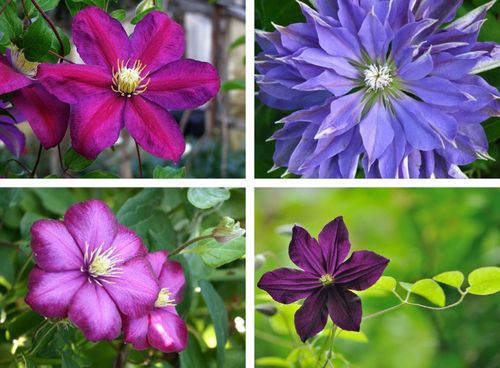
Sometimes seedlings are grown before planting in open ground so that they get stronger and acquire a powerful root system. Only after this is clematis planting from seeds to a permanent place - these plants do not like transplanting. It is better to choose it in advance so as not to disturb the roots later. Further care of the vines is simplified: now it is necessary to water the seedlings abundantly only in dry periods, in summer. Bushes are fed once a month, alternating mineral and organic fertilizers. Most clematis need pruning: depending on the species, it can be complete or partial. Shelter for the winter will also be required.
It is important to plant clematis correctly, choose a bright place, sheltered from the winds, with suitable nutritious soil. They do not like stagnant water, and if the groundwater is close, drainage from broken brick, expanded clay or crushed stone is poured at the bottom of the planting pit
You can fill a small hill, raising the root system so that there is no high humidity, and maintenance becomes easier. Planting begins with an examination of the roots: the patients remove it by sprinkling the damage with charcoal, straighten the roots in the pit and cover it with earth, leaving a small depression to add fresh soil as clematis develops. It is better to tie the shoots to a support immediately so that they are not broken by the wind.

Conclusion: Clematis can be propagated vegetatively or grown from seeds. The easiest way to use this breeding method is for small-flowered clematis. The easiest to grow are the Tangut (Radar of Love) and Manchurian varieties, as well as the large-flowered The President. Seeds can be of different sizes, the sowing time depends on it.
Planting large seeds should be done after cold stratification.
It is important to properly care for the seedlings: water through a pallet and shade from direct sunlight. Can be planted immediately in the ground when the snow falls - after 3 months shoots will appear
Caring for young plants consists of watering, regular feeding and proper pruning of shoots. Clematis will need shelter for the winter. Plants bloom from seeds in 1-3 years.
Caring for clematis after planting
Taking care of this flower culture is not difficult at all. However, in the first year after planting clematis in open ground, you need to be a little more sensitive and attentive gardener, and take full care.
In the first year after planting in open ground, you need to be very careful about watering clematis. Moisture must be introduced into the groove. Do not allow the soil to dry out.Water regularly while maintaining a moderate humidity
But it is also very important not to overflow the plant, because waterlogging is dangerous and critical for this crop. It should be watered roughly once a week, and in hot and dry weather - 2-3 times a week.
Watering is reduced in autumn.
Immediately after planting and thereafter, it is recommended to mulch the area around the plant. Mulch performs the most important function - it retains moisture in the soil. It also protects the root system from overheating on hot and dry days. Peat, rotted sawdust, straw can be used as a mulching material, the optimal layer thickness is 5-7 cm.
It is recommended to plant marigolds or calendula next to clematis on the site. Such good neighbors not only look beautiful together, but they can protect the plant from pests (in particular, from nematodes).
The soil around the flower must be loosened regularly after each watering or rainfall. Loosening improves oxygen supply to the roots and improves soil structure.
Weeds cannot be ignored. At the slightest sign of weed, it must be weeded.
In the first year after planting in the open field, it is necessary to cut clematis in the fall as follows: all shoots must be cut off, leaving 30 centimeters above the ground. In subsequent years after flowering and before the onset of winter, pruning must be done. But the procedure must be carried out depending on the clematis group (and there are three of them). The picture shows a scheme for trimming clematis: on the left 1 group, in the center - 2, on the right - group 3.
Autumn before the winter cold, you need to take care of shelter from the cold and winds. Shelter for the winter should be done just before the frosts. Such an element of care is especially important when growing clematis in regions with cold winters, for example, Siberia, the Urals, the Leningrad region, the Moscow region.
Features of growing clematis from seeds
Cultivation of clematis is also possible from seeds. To do this, you need to plant seeds for seedlings at home. However, only specific flowers can be grown from seeds, but this method of propagation is not suitable for hybrid varieties and large-flowered plants!
It is recommended to stratify the seeds before sowing seedlings. To do this, sow them on coconut substrate or universal soil for seedlings, slightly press into the soil, moisten, sprinkle with substrate on top, water again, put in a bag and put in the refrigerator for 1-2 months. Seedling care is the same as for other crops.
Video: features of growing clematis from seeds.
It is very easy to plant clematis in open ground in spring. If you follow the scheme, rules and instructions, then even a novice florist and a beginner in gardening will cope with the task.
In the subsequent, it is very important to properly and fully care for the plant, observing the recommended cultivation techniques. The plant will show all its beauty only after three to four years, so do not be discouraged when at first it will not be as beautiful as in the photographs
But then he will show all his beauty, which can charm even the most inveterate garden cynic.
Step 2 - picking clematis seedlings
When the seedlings have two true leaves, the plants need to be cut into separate containers or into volumetric boxes so that the distance between the shoots is 15-20 cm.To transplant, it is necessary to use light loose soil that allows air to pass through well. Carefully remove the seedling along with a clod of earth and transplant it into a new container so that the root system of the plant can develop freely (the earth cannot be tamped!).
After transplanting, in order to avoid decay, as well as to simplify the access of nutrients to the root system of young plants, watering must be carried out only in the pan. Moisturizing should be regular but moderate.When it gets warmer outside (in regions where return frosts are possible - not earlier than summer), transplant clematis into a flower garden.
If there is a heated greenhouse, the seedlings can be cut into it. And with the onset of stable warm weather, transplant it into open ground.
Reproduction
This type of clematis is propagated by seeds and cuttings. Each of the breeding methods has its own nuances.
Seeds
Growing from seeds involves preparatory measures:
- Overwintered seeds will give more shoots.
- Before planting, the seeds should be soaked in cold water for about a week.
- You can sow in wooden containers or special containers.
- Seeds should be planted in a special mixture, which includes sand, peat and ordinary earth in proportions of 1: 1: 1.
- After planting, the seeds must be sprinkled with sand.
- During germination, the room should be kept at a temperature of 25-28 ° C, while it is better to cover the container with a plastic wicker or glass.
- Watering is carried out using a pallet method.
- As soon as the first leaves appear, the boxes can be placed in the light. However, they should not be exposed to direct sunlight.
- With the onset of spring, the shoots are transplanted into the ground. The distance between them is 20 cm.
- The garden bed should be insulated for the winter.
- After the first flowering period, the plant remains in place for another 2-3 years.
Cuttings
Propagation by cuttings is much easier. They are unpretentious and therefore do not need special care.
Cutting has its own characteristics:
- It is carried out in the spring, at a time when clematis is most actively growing.
- Cuttings need to have time to prepare when buds barely appeared on the branches.
- Liana can only be cut by 1/3. After pruning, it is cut into several cuttings of equal length.
- Each segment should contain a pair of nodes. From the top edge to the first knot should be no more than 3 cm, and from the bottom edge, the knot should be located at a distance of about 10 cm.
- Before planting, the cuttings should be treated with special agents - growth stimulants.
- For planting, you can use ordinary soil, pre-fertilized with microelements.
In addition to cuttings and seeds, clematis propagates by dividing bushes and layering.
Preparatory work
To grow a healthy plant, you need to properly prepare for planting. It consists of two stages:
- Choosing a place. Clematis loves light, so plant it where the sun shines most of the day. It is not recommended to choose the northern walls. Also, do not plant a plant near the wall itself, since a lack of space will lead to its death. Not suitable for disembarkation and a place where there is groundwater. Finally, clematis must be protected from the wind.
- Soil selection. It is desirable that it be sandy or clayey. The soil must allow both air and water to pass through. Preference should be given to earth that is rich in humus.
Clematis will not grow well in soil that contains lime.
Correct fit
How to plant Manchurian clematis correctly? Like any other variety, in pre-prepared soil. The planting process has some features:
- The land should be prepared one year before planting the plant. Substances are added to the pit that will be useful at different periods of his life - peat, humus, ash, etc. Also, a layer of broken brick should be poured into the pit, which can be replaced with expanded clay or crushed stone.
- The depth and width of the pit is 60 cm.
- Saplings are planted at a distance of about a meter from each other.
- Before planting, each seedling should be placed in a container with water and growth activators.
- The drainage must be covered with earth. After pouring. Place the seedling in the hole, carefully straightening its roots.
- Sprinkle soil about 15 cm.
- Water the planted plant. Cover the ground with peat or sawdust on top.
At the end of planting, you can install the support.
Techniques for increasing seed germination
Seed germination of many varieties of clematis leaves much to be desired. For example, in clematis Tangut, it is about 70%, while in the varieties "Armanda" it does not exceed 21%. In addition, for each specific plant, this parameter can vary greatly from year to year, depending on climatic conditions and agricultural technology.
 In the photo - Armanda's clematis "Apple Blossom"
In the photo - Armanda's clematis "Apple Blossom"
To increase the seedling yield during sowing and get stronger seedlings, a variety of methods of processing the seed are used:
- Soaking. Seeds (usually belonging to the large or medium groups) are kept in water at room temperature for 5-10 days, and the liquid is completely changed every 5-6 hours.
- Washing. The method is similar to the previous one, but the seed is soaked in running water.
- Sparging. The seeds are placed in a container of water, through which a stream of air is constantly passed using a small compressor. The procedure takes about 40-50 hours. According to breeders, this treatment significantly reduces the germination time and allows you to get strong, healthy seedlings. Sometimes a "two-stage" option is used - for 5-6 hours the seeds are bubbled in a solution of baking soda (1 teaspoon per 200 ml of water), and then another 3-5 days in clean water, changing it every 8 hours.
- Stratification. The containers with the sown seeds of large-flowered clematis are first kept for 2 weeks at a temperature of about +20 ℃, and then placed in a cool place (not higher than +5 ℃) for 1.5-2 months. The first shoots can appear 3-4 weeks after the crops return to warmth. It is believed that in this case the seeds germinate much faster and more amicably. According to some reports, the percentage of seedlings obtained can increase to 85-90.
- Scarification. It is known that seeds of many crops germinate more easily when their strong outer shell is broken. Large clematis fruits are processed using the method developed by the Belarusian breeder P. N. Lomonos - the seeds are soaked for 2 days, periodically changing the water, then the "skins" are removed from them, and the internal "nucleoli" are sown.
- Treatment with growth stimulants. The most commonly used drugs are "Epin", "Cytovit", "Sodium humate" or succinic acid. Working solutions are made in accordance with the manufacturer's recommendations and the seeds are kept in them for 30 minutes.
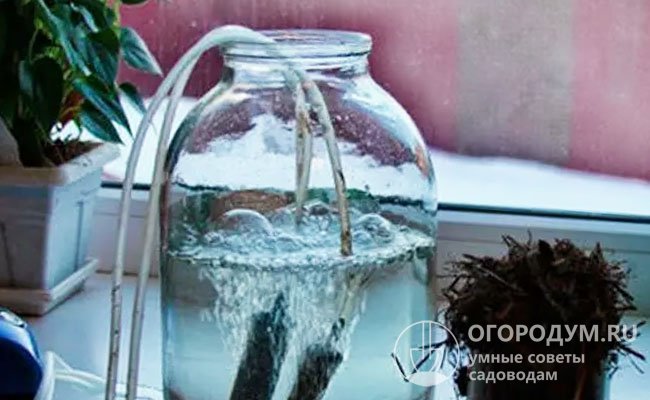 The simplest design for bubbling seeds at home
The simplest design for bubbling seeds at home
Many experts combine methods of increasing germination (for example, bubbling or soaking the seed, and then treating it with growth stimulants). In most cases, the method of pre-sowing seed treatment is selected separately for each type or variety of clematis, since there are no strict recommendations on this matter.
Open ground planting rules
Seedlings, which started growing from seed in the fall, are ready for transplanting outdoors in mid-spring. No one will name the exact date, since everything depends on weather conditions, night and day temperatures. If the seeds were planted in the nutrient mixture in the spring, then it will be possible to plant the sprouts in a permanent place only in the fall. Only some varieties can be kept until spring, for example, Clematis "Lomonos".

Despite the wide variety of varieties, it is preferable to plant clematis in places that meet a number of requirements:
-
deep bedding of groundwater, otherwise you will have to organize high-quality drainage, but it is better to abandon this place and think about another location of the garden culture;
-
although clematis is a photophilous plant, its roots should be in the shade;
-
drafts are one of the main enemies of the graceful liana, therefore you need to plant the shoots in a quiet place, protected from the winds;
-
the support for the plant must be thought out in advance: will it be natural (trees, bushes) or artificial (fence, arch).
Planting clematis sprouts is carried out according to the following rules:
-
make a hole up to 80 cm deep;
-
we place bricks, sand, expanded clay at the bottom for high-quality drainage;
-
lower the seedling, gently straighten the roots;
-
we fill the voids with high-quality fertile soil in such a way that the sprout is deepened by 10 cm to the first bud, and not just to the root collar;
-
leave a distance of up to 10 cm to the edges of the pit;
-
Water the clematis abundantly and mulch it with peat.
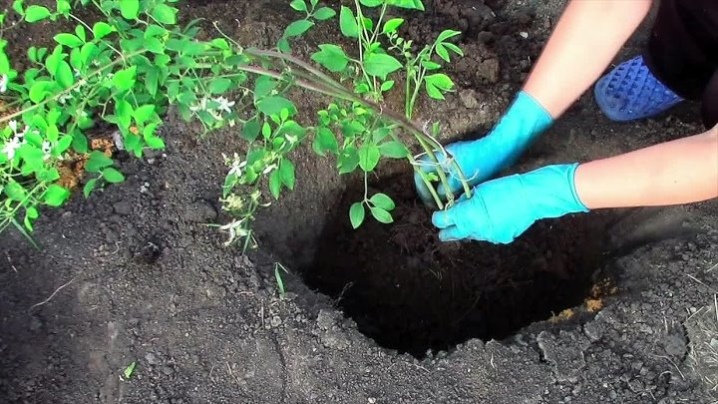
Landing in open ground
It is advisable to prepare the soil for transplanting seedlings in the fall. For this, holes are dug 40 x 60 centimeters in size. Drainage is laid on the bottom - expanded clay, crushed stone or broken brick - with a layer of about 15-20 centimeters. The rest of the volume is filled with fertile soil or compost.
It is necessary to transplant clematis from a box into open ground only when the threat of night frost is definitely excluded. For central Russia, this is the end of May or even the beginning of June. An unfortified plant may well ruin even a short drop in temperature.
The soil in the box must be well moistened, then carefully and quickly remove the sprout along with the substrate and plant in the place designated for it.
In doing so, it is important not to damage the fragile root system. That is why it is better to use separate cups - here the roots of the two sprouts will definitely not intertwine and there will be no danger of damage
It remains only to water the soil abundantly and mulch it well - needles, sawdust or grass will do.
Clematis: agricultural technique of planting seeds in spring for seedlings
Many are interested in how you can grow clematis from seeds. It is recommended to do this in a seedling way.
What do clematis seeds look like?
Seeds are as follows:
- small ones sprout from 2 weeks to 4 months;
- average. Sprouts appear in 1.5-6 months;
- large. Seedlings will appear only after 1 year.
Seed stratification
Medium and large seeds are distinguished by long germination, so they need to be prepared for planting - stratification. This process is considered very lengthy and takes 3 months.
Important! If you plan to plant seeds in open soil in late spring, preparation should begin in mid-November or early December. Seeds should be placed in a container with nutritious soil and sprinkled
Planting depth depends on the grain size. Large ones need to be deepened by 2 cm, medium ones - by 1 cm. Then the container with soil should be held at a temperature of 5 ° C for several months. This can be done in the refrigerator or under a layer of snow.
The seeds should be placed in a container with nutritious soil and sprinkled. Planting depth depends on the grain size. Large ones need to be deepened by 2 cm, medium ones - by 1 cm. Then the container with soil must be held at a temperature of 5 ° C for several months. This can be done in the refrigerator or under a layer of snow.
Medium seeds can be stratified 1 month. Large grains will take at least 3 months. Then the containers need to be placed in a warm place.
Before sprouts appear, it is important to ensure that the soil is moist.
Note! When stratification of seed in the snow, he needs to provide high-quality protection from rodents. To do this, use a fine mesh or a durable plastic container.
Preparing soil for clematis seedlings
All varieties of clematis can hardly tolerate acidic soil. It is strictly forbidden to plant them in soil with a high peat content.
It is better to make the optimal composition for growing yourself. To do this, you need to take humus, fine sand, sod soil and ash.
Seed preparation for sowing
If there is no time to carry out stratification before growing clematis seedlings, the seeds should be soaked in water for 5 days. Moreover, it needs to be changed every 3-4 hours. Then the seed is recommended to be bubbled for a week. It is enough to soak small seeds for several days.
Planting seeds in the ground
After the completion of the preparatory work, the seeds should be planted in boxes or pots filled with fertile soil, which should be placed in a room with a temperature of 21-25 ° C. The container should be on a well-lit windowsill. The land needs to be watered systematically.
Important! When the sprouts appear, they need to provide good lighting. At the same time, plantings need protection from direct rays of the sun.
Seeds need to be planted in boxes with fertile soil
Seedling care
At the stage when 2-3 true leaves appear, the seedlings should be moved to plastic containers. Their diameter and depth should be 9 cm. The seedlings should be removed as carefully as possible.
In early June, the bushes should be taken out into the open air. It is best to make a small greenhouse for them. Plants need regular soil moisture and fertilization.
Good care includes the following activities:
- the upper part of the stem must be pinched;
- during the season, liquid complex dressings should be applied 2-3 times;
- cut off shoots in autumn for the winter, leaving 2-3 internodes;
- cover the base of the shoots with a mulching layer.
Note! In the southern regions, seed clematis should be grown outdoors. Saplings in the open air develop much faster

Seedlings of clematis need timely watering and fertilization

